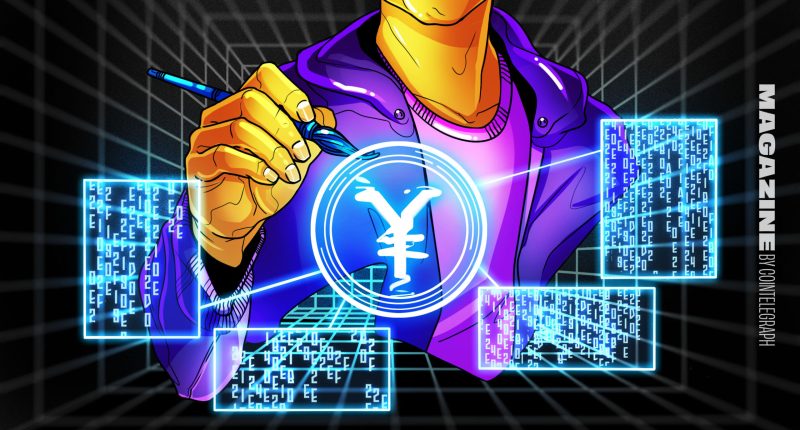Table of contents:
– History of the digital yuan
– How is the digital yuan used in China?
– China is primed for digital yuan by Alipay
– The digital yuan abroad
– Is the digital yuan a threat to the US dollar?
– BRICS and de-dollarization
– The digital yuan, SWIFT censorship and sanctions
– The digital yuan and mBridge
– American politicians attempt to ban the digital yuan
– Is the digital yuan a tool for surveillance?
– The digital yuan and crypto
China’s central bank digital currency is known as the digital yuan, e-CNY or e-RMB and despite the hype, it represents a minuscule portion of the money supply and has only been used at any scale a few times internationally.
But politicians, bankers, activists and businesses worldwide pay outsized attention to it. Opinions about the digital yuan vary, but they are almost always extreme. It’s seen by some as a world leading advance, and by others as an instrument of oppression and a way to subvert US sanctions. As with everything else in crypto, it’s probably too early to tell. But the potential is massive… for good or ill.
History of the digital yuan
The digital yuan originated with a project launched by the People’s Bank of China (PBOC) in 2014. At the time, central bank digital currencies or CBDCs were a new idea discussed only in specialized circles. Interest in the topic soon took off however, and the PBOC Digital Currency Research Institute (DCRI) was formed in 2016.
In late 2019, a digital yuan pilot project was launched in four areas — the cities of Shenzhen, Suzhou and Chengdu, and the Xiong’an New Area. While still in the pilot phase, the digital yuan has expanded to 21 areas in China and was used at the 2022 Winter Olympics, exposing foreigners to it for the first time. Some United States politicians have advised against using it, talking about “digital authoritarianism.”
A PBOC report claimed that, as of January 2022, there were more than 260 million digital yuan wallets, and 87 billion yuan ($13.7 billion at the time) in transactions had been conducted. PBOC governor Yi Gang said in July last year that there were around 950 million transactions from around 120 million wallets since the earlier figures. However that still means the digital yuan represents a paltry 0.16% of the monetary supply.
The user numbers seem impressive — only four countries in the world have populations larger than 260 million. In a country of approximately 1.4 billion, if the digital yuan wallets had unique users, which is not clear, they would represent around 19% of the population. But many users may have had limited exposure to the digital currency, and may be counted as “users” after taking advantage of a single promotional airdrop or discount, for example.
By comparison, the dominant electronic payment market players in China, Ant Group’s Alipay and Tencent’s WeChat Pay, have been operating electronic payment systems since 2004 and 2005, respectively. They each have over one billion users, with Alipay ahead by around 200 million. Chinese payment service providers reportedly processed a combined total of 290 trillion yuan ($42 trillion) in transactions in 2020.

Only three other CBDCs have been launched and remain active, according to website CBDC Tracker. It is difficult to find detailed user statistics but according to various sources, Nigeria’s eNaira has an adoption rate of 6%, Jamaica’s Jam-Dex 7% and the Bahamas’ Sand Dollar 25%.
How is the digital yuan used in China?
From the start, officials saw the digital yuan as a retail innovation. Speaking in late 2020, former PBOC governor Zhou Xiaochuan told students at Peking University:
“The driving force mainly comes from the demand side, as consumers hope to cut costs, improve convenience and obtain better services by enhancing the efficiency of the payment system, especially retail payments.”
The digital yuan was developed in conjunction with major banks. It is intermediated, meaning that it depends on a “second-tier” of financial institutions for its operations. According to a recent overview published by the Chinese University of Hong Kong, six state-owned commercial banks, two private commercial banks and two private neo-banks form the second-tier institutions. They distribute the digital yuan, establish payment networks and interact with technical services providers. This arrangement spreads operational risks and reduces costs for the PBOC.

The digital yuan does not operate on a blockchain due to throughput issues but the system features smart contracts, which means that the uses of the money can be controlled by the issuer. Smart contracts also unleash new financing capabilities, which have been used in China’s power industry.
There are three wallet options that vary by transaction limit and Know Your Customer measures. Wallets linked to bank accounts are fully verified and can be used for high-value transactions. A quasi-account-based wallet can be linked to a phone number or email. This is the type of wallet issued to foreigners at the Olympics. It has a limit of 2,000 yuan (around $280) per transaction and 5,000 ($695) per day.
The digital yuan smart card imposes the fewest use restrictions and offers the greatest inclusiveness. The preloaded card is NFC-enabled to make transactions with the digital yuan offline — a feature that currently bedevils CBDC designers. It also encourages inclusiveness, as it can be used in areas without internet. In addition, since it costs nothing to use, it makes very small transactions practical.
The smart money card “feels genuinely innovative,” Willamette University assistant law professor Rohan Grey tells Cointelegraph. The cards will “let them go digital before they even finish electrifying the country.”
Related: Ant Group highlights private sector’s role in developing digital yuan
China is primed for digital yuan by Alipay
China has been at the forefront of payments technology for some time. Payment via QR code was introduced by Alipay and WeChat in 2014, making it possible for anyone who could print out a QR code to carry out an electronic transaction. Grey says:
“I saw people homeless on the street with a QR code in front of them.”
QR code sharing between the digital yuan and Alipay, WeChat Pay and UnionPay QuickPass is currently being trialed.
Grey describes the government’s approach to China’s payments market as “You want the whole stack, but you start at the bottom.” Alipay and WeChat provide access to the digital yuan through apps, and the state has tightened reserve requirements for them within the last four years from below bank level, to bank level, and then to 100% backing, Grey says. He adds that he expects the squeeze to continue. China announced new, stricter regulations on non-bank payment in December.
DCRI director general Mu Changchun has said the digital yuan should be usable “in all payment scenarios.” It is, after all, a national currency. To meet that goal, the Chinese government has established a voluminous set of highly specific “application scenarios,” and their efforts can be seen in programs such as paying government salaries in digital yuan and making it interoperable with online retailing and services like local buses and air travel. In addition, the digital yuan has uses that complement Alipay and WeChat Pay, such as paying taxes and receiving government social benefits.
Related: Digital yuan app adds prepaid Mastercard, Visa top-ups for tourists
Despite these efforts, officials have expressed dissatisfaction with digital yuan adoption more than once. The government has promoted the digital yuan energetically, with holiday and other airdrops and user discounts that may at times be intended to compete with the private payment systems and stimulate the local economy.
The digital yuan abroad
In spite of the retail orientation of the digital yuan, the wholesale side may hold great promise and foreign trade provides innumerable new use cases.
Related: Chinese, Indian investment professionals show strong support for CBDC in new survey
Recent examples include a “major step forward” on Oct. 19, when PetroChina International completed a deal for 1 million barrels of crude oil on the Shanghai Petroleum and Natural Gas Exchange using the digital yuan. Another milestone was reached on Nov. 5, when the Taiwan branch of China’s Xiamen Xiangyu Group issued the first digital yuan bond. Gold and iron imports have been settled with the digital yuan as well.
China has also opened new cross-border payment corridors using the digital yuan. It has established new payment solutions with Singapore’s DBS Bank, the French BNP Paribas, Standard Chartered, HSBC, Hang Seng Bank and Fubon Bank.
The Construction Bank of China, one of the state-owned tier-two digital yuan providers, entered into an agreement with Singapore’s Thunes payments company in October to create two new services. One, called Shu Duo Hui, will help Chinese e-commerce merchants accept payments from overseas by converting foreign currencies into digital yuan. The other — Shu Shan Da — will allow people in China to send “tuition fees and other funds” abroad.

Is the digital yuan a threat to the US dollar?
The use of the digital yuan certainly meshes with the growing de-dollarization of the global economy. China is now the main trading partner of 140-150 countries. Its trading relations are growing fastest among developing nations, and the Association of Southeast Asian Nations is its most important partner in aggregate terms.
Digital currency has been seen as a particular threat to dollar dominance. This is at least in part due to the strongly negative perception of CBDCs that is common in the United States.
“Even limited international usage of the digital yuan and other virtual assets could impact the dollar’s reign in international payments,” Mike Heller, head of financial crime proposition at Dow Jones Risk & Compliance, tells Cointelegraph.
China is acting to further de-dollarization on several fronts simultaneously. China’s decade-old, multibillion-dollar Belt and Road Initiative (BRI) seeks to create transportation infrastructure across Asia, Europe and Africa, with a launch date of 2049. In spite of Western criticism that the project is a “debt trap,” it has been heartily embraced internationally. More than 150 countries have entered into more than 230 cooperation agreements with China.
The BRI could provide myriad use cases for the digital yuan. Grey compared a BRI supported by the digital yuan to Amazon Web Services: China would control the rails and collect data while others do the development work. A digital yuan-powered BRI would give China a reserve currency of choice, while keeping China’s global competitors, and private business, away from the data.
In July, Chinese President Xi Jinping also proposed that the members of the Shanghai Cooperation Organization “expand sovereign digital currency cooperation.” The nine Eurasian member states in the economic, defensive and political body account for around 40% of the world’s population and 20% of its GDP.
Read also
Features
Dictators turn delegates: Former CEOs grapple with DAO governance
Features
Extinct or Extant: Can Blockchain Preserve the Heritage of Endangered Populations?
BRICS and de-dollarization
Although it is not directly a platform for the digital yuan yet, BRICS, the economic and political alliance of Brazil, Russia, India, China and South Africa, may embrace something similar and is at the forefront of de-dollarization. Iran, Ethiopia, Egypt and the United Arab Emirates joined the alliance in January 2024, and over 30 more countries have reportedly expressed interest in membership.
BRICS has proposed creating its own currency, which may or may not be backed by gold. Russian economist Sergey Glazyev told BRICS TV on Oct. 25 that “technically this currency is almost ready, the software and mathematical tools have been created.”

The digital yuan, SWIFT censorship and sanctions
Jerome Powell emphasized that China’s CBDC showed its need for a reliable currency more than an attempt to displace the dollar. “China has lots of U.S. dollars. It doesn’t want to destroy them,” he said. But the dollar’s use as a vehicle currency in trading between third countries gives the United States influence, and the United States could “get cranky” at the digital yuan’s rise.
Despite not being on a blockchain, the digital yuan may offer a form of censorship resistance in that it may be resistant to financial sanctions. This thesis has not been tested extensively, but if it is true, it will be mainly due to its independence from the SWIFT (Society for Worldwide Interbank Financial Telecommunication) network. That’s the network that connects 1,000 financial institutions — including banks, intergovernmental agencies, investment managers and others — in more than 200 countries.
Related: Is payments giant SWIFT preparing for a blockchain-bound future?

Since it is based in Belgium, SWIFT is required to adhere to European Union law, including sanctions legislation that requires it to deny access to institutions in certain countries. The United States has forced SWIFT to abide by its sanctions.
The use of financial sanctions has increased steadily since the 1980s, according to the NY Fed:
“Most sanctions are imposed by North American and European countries targeting Asian and African countries. Financial sanctions are more likely to be used than other sanctions when the goals are promoting democracy and human rights.”
In other words, sanctions tend to hit China’s trading partners. There are around 12,000 individuals and companies under U.S. sanctions.
SWIFT was always an imperfect means of imposing sanctions and its syntax is open source, so its operations have been reproduced in competing systems. That was partially the case of the Chinese Cross-Border Interbank Payment System (CIPS), created by the PBOC in 2015 and also includes a payment component.

In January 2022, CIPS had 1,280 participants from 103 countries, including major U.S. banks. But its payment volume was only around 0.3% of SWIFT’s. China is a regular user of SWIFT as well.
However U.S. Deputy Treasury Secretary Wally Adeyemo said in 2021 that he does not believe that CBDCs will foil U.S. sanctions. “We believe that even if a digital [Russian] ruble or other digital currencies come into place, there will still be scope for our sanctions to have an impact on their economies simply because the global economy is still interconnected,” he said.
Related: China’s Digital Yuan Is an Economic Cyberweapon, and the US Is Disarming
The digital yuan and mBridge
China is participating in one the most promising of the several CBDC interoperability projects affiliated with the Bank for International Settlements (BIS) — Project mBridge. The central monetary authorities of Hong Kong, Thailand and the United Arab Emirates are also active participants.
Five commercial banks from each country are also participants. The BIS recently released a publication describing the project in detail, including the 25 central banks and other organizations that have observer status in it.

The project uses technology developed by the Hyperledger Foundation, part of the Linux Foundation.
“mBridge is a great example of the level of collaboration that is required to support new CBDC models in a global economy,” Hyperledger CEO Daniela Barbosa tells Cointelegraph. “Open source software, including Hyperledger Besu, has played a key role in the evolution of mBridge, providing building blocks that are not only hardened by the community behind it but that are extensible, flexible and not beholden to any single vendor.”
But CBDC bridges could impact cross-border banking by weakening the correspondent banking system. Correspondent banks form bridges by providing services for a partner bank in countries where the partner does not have representation. By cutting out the correspondent banks a cross-border transfer may pass through, CBDC bridges reduce the opportunities for Know Your Customer (KYC) and Anti-Money Laundering (AML) verification.
Using mBridge, a money transfer would be subject to KYC/AML only by the sending and receiving banks. There are concerns this could lead to violations of Financial Action Task Force (FATF) policies meant to combat money laundering and terrorism. Enforcement of FATF measures becomes a question of the will of the transacting banks and the countries they are located in.

As of October 2023, there were 23 countries on the FATF “gray list” who are “working with the FATF to address strategic deficiencies” in their KYC/AML procedures.
Ranking member of the U.S. House Financial Services Committee Maxine Waters in September called for a study of Project mBridge’s potential to help China evade sanctions.
Related: Bank for International Settlements will test DeFi implementation in forex CBDC markets
American politicians attempt to ban the digital yuan
The digital yuan has made a big impression in the halls of the U.S. Congress. Lawmakers have made several attempts to contain it. The latest was on Nov. 8, when Florida Republican Senator Rick Scott and colleagues in the House and Senate re-introduced the “Chinese CBDC Prohibition Act.”

Scott’s bill, which was first introduced in the previous Congress, would prohibit U.S. money services businesses from engaging in transactions involving the digital yuan. Scott said in a statement:
“Secretary Xi and his thugs have no business playing big brother to American citizens and how they spend their money. That is why I am fighting to prevent this problem from ever becoming someone’s reality.”
In 2022, Scott was among the nine backers of the “Say No To the Silk Road Act,” which did not reach a vote. His cosponsors on the 2023 bill, Ted Cruz and Marsha Blackburn, also backed it. The act would have required various forms of reporting and warnings about the digital yuan.
“If left unchecked, technologies including China’s Digital Yuan will empower Russia to evade global sanctions on systems such as SWIFT and enable the CCP [Chinese Communist Party] to further surveil and threaten their citizens,” Blackburn said in a statement.
Related: China’s Digital Yuan Is an Economic Cyberweapon, and the US Is Disarming
Also in 2022, Republican Senators Tom Cotton, Mike Braun and Marco Rubio introduced the “Defending Americans from Authoritarian Digital Currencies Act” to ban the digital yuan app from U.S. app stores. “The Chinese Communist Party will use its digital currency to control and spy on anyone who uses it. We can’t give China that chance,” Cotton stated. The app remains available in the United States.
Heller expressed similar reservations. “The design of the digital yuan raises important questions about the trade-off between performance, policing and privacy in the fight against financial crime,” he said.
Is the digital yuan a tool for surveillance?
While users in the west worry about the digital yuan becoming a tool for surveillance and censorship, the picture is more complicated.
China has a suite of data protection laws that cover the privacy of personal data, financial data and other aspects of business and personal life. The laws’ application is complex, however, and data breaches such as the Shanghai Police leak in 2022, which exposed data on a billion people, shed light on the extent of government surveillance.
Zhou claimed that one of the functions of the digital yuan was “to protect individual data privacy and fight against telecom and payments fraud.” He added, “In China, fraud via mobile phones and other internet systems occurs often, which is a major concern for authorities and the public.” The digital yuan has proven to be susceptible to criminal uses too, however. Cases of spoofing and money laundering have been reported.
Speaking at Hong Kong Fintech Week in November 2022, Zhou’s successor Yi said the digital yuan would provide “controllable anonymity.” He added, “We need to strike a precise balance between protecting individual privacy and combating illegal activities.” To many, Zhou and Yi’s statements may seem uncontroversial. Grey says:
“There isn’t much daylight between what Janet Yellen and Jerome Powell have said about privacy and the Chinese government [position].”
“You have a larger problem where you do not trust China as an entity,” Richard Turrin, author of Cashless: China’s Digital Currency Revolution, says. At least the PBOC does not sell users’ data, Turrin points out.
The reasons why China is mistrusted are too numerous to list. But the United States is at least a decade behind China in payment technology and is continuing to lose ground, Turrin says. The United States is not vying with China in this domain, but with Europe to occupy a distant second place.
Alluding to other reasons some oppose CBDCs, especially in the United States, Turrin said:
“Since when is using a Visa or Mastercard approved by God and a CBDC is a sign of the end times? […] Right now you [in the United States] are living in a dystopian payment world.”
Opponents of CBDCs are “lying” about the technology out of self-interest, and its use for mass surveillance is one of the lies being told, Turrin argues.
Read also
Features
Game theory meets DeFi: Bouncing ideas around tokenomic design
Features
Lines in the sand: US Congress is bringing partisan politics to crypto
The digital yuan and crypto
As documented earlier by Cointelegraph, the digital yuan may offer advantages domestically beyond its potential for surveillance. Stringent capital controls are in place in China, as the country deals with a recession (that is aggravated by sanctions on high-tech products, among other things).
The digital yuan may provide a more manageable alternative to cryptocurrency and stablecoins for transferring capital abroad. Thunes’ Shu Shan Da, for example, can carry out select capital exports, such as tuition fee payments, using the digital yuan, while preserving the government’s power of financial censorship.
Related: CNHC stablecoin issuer detained by Chinese police: Report
The Chinese government has another reason to dislike crypto — it actively supports the greenback. As the NY Fed wrote in a note in January 2023:
“About 99 percent of stablecoin market capitalization is linked to the U.S. dollar, implying that crypto assets are de facto traded in U.S. dollars.”
The crypto community’s antipathy toward CBDCs is well known, but that feeling may not extend through all of Web3. Michael Carbonara, CEO of digital banking platform Ibanera tells Cointelegraph, “Fintech companies like ours will eventually have to change and adapt in order to compete.”
Daniel A. Strele-Ramonis, founder and CEO of Web3-ready financial services platform Renegade, said, “The impact of the digital yuan on Renegade and other fintechs will be defined by their readiness to adapt. […] It remains to be seen if this will be a pivotal moment.”
Currencies exist in a marketplace like nearly everything else in the world. Neither the U.S. nor Chinese government is capable of deciding whether its currency, Bitcoin or anything else will power the world’s markets. The digital yuan has existed for less than a decade. It may be well positioned to take off. Even if politics and economics get in the way, it will surely raise the bar for fintech forever.
Subscribe
The most engaging reads in blockchain. Delivered once a
week.

Also Read More: World News | Entertainment News | Celebrity News








